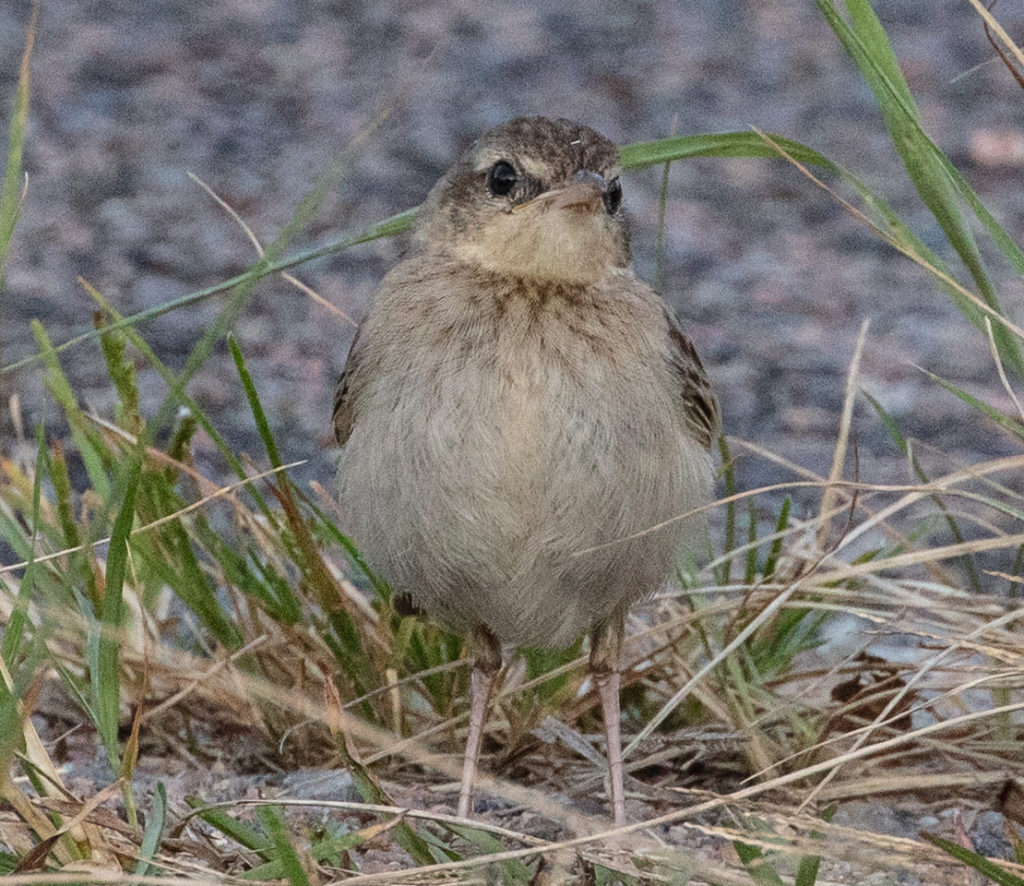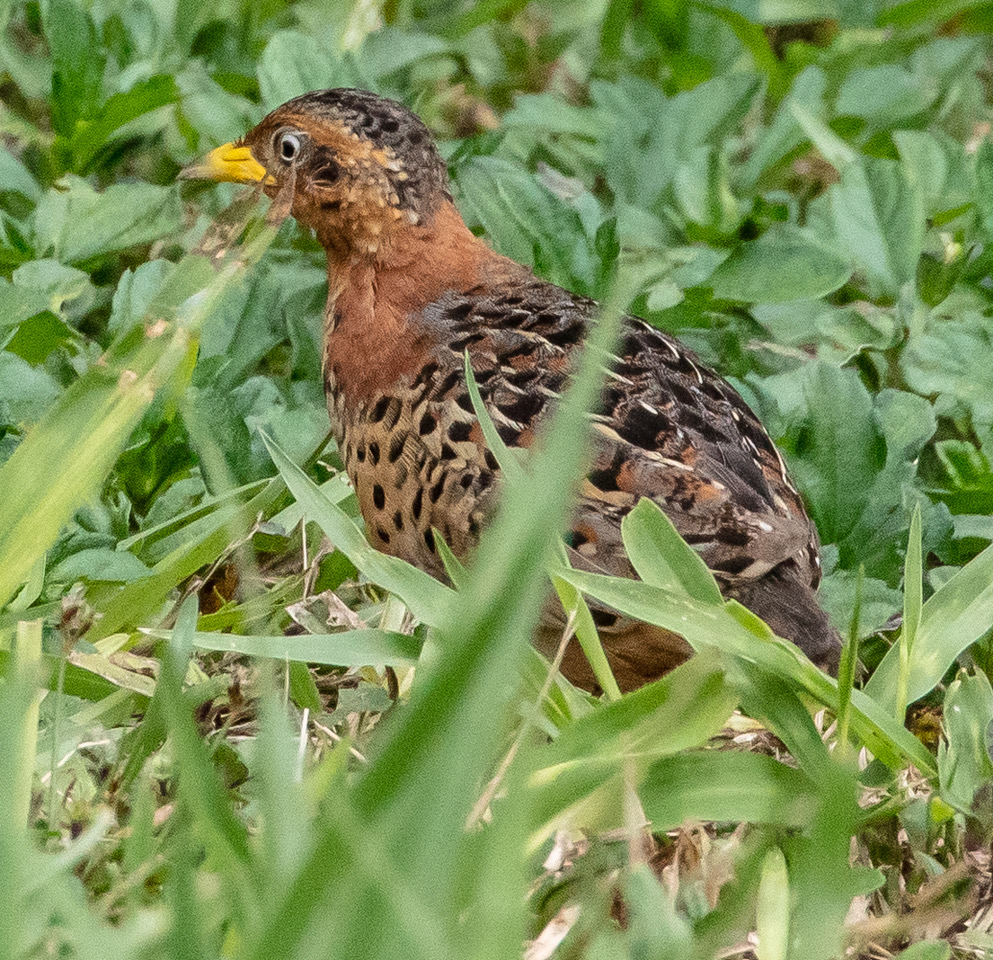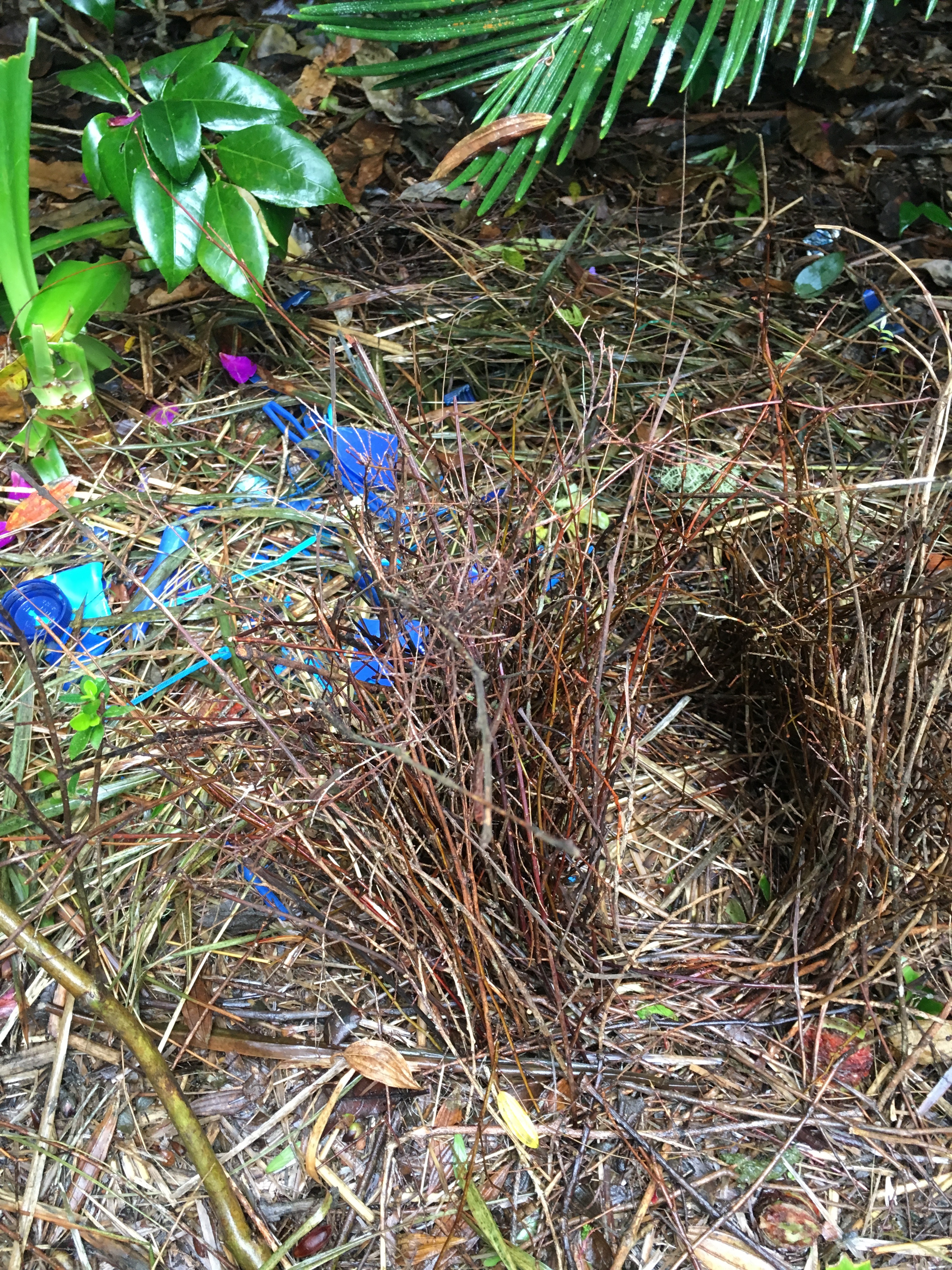Following on from our previous post on 9th December regarding the Shrike-Thrush chicks at Lynda’s place. At about 7 to 8 days of age, the chicks are thriving in the nest. They are growing steadily and just look at those wing feathers!


Following on from our previous post on 9th December regarding the Shrike-Thrush chicks at Lynda’s place. At about 7 to 8 days of age, the chicks are thriving in the nest. They are growing steadily and just look at those wing feathers!


Some exciting news from Lynda Radbone’s garden in the central sector of Paluma Village. A few weeks ago a pair of Shrike Thrush birds started nesting in Lynda’s fig tree. After some frenetic nest building, some eggs appeared in the nest to be closely cosseted by Mum and Dad Shrike Thrush. Earlier this week, the eggs hatched and there are three splendid and very hungry chicks in the nest. Lynda continues to monitor the nest to guard the chicks from hungry Catbirds, with the help of Miss Molly the dog. Lynda has kindly shared these photos of the progress of this little feathered family.




The Australian King Parrot (Alisterus scapularis) is found from Cairns to Melbourne. This male was foraging by himself on the dried fruit of an Alphitonia tree (known locally as sarsaparilla tree) near the Paluma Community Hall. Birds from southern Australia are larger than the northern sub-species Alisterus scapularis (minor). Lloyd Neilsen (Birds of the Wet Tropics) says they are uncommon at Paluma and Mt Lewis, but Andree Griffin and Roy Mackay class it as a breeding resident in an area from Little Crystal Creek to Mt Spec and Taravale.
Text & Photos by Peter Cooke


Two species of shrike-thrush are commonly seen at Paluma — the Little Shrike-Thrush (Colluricincla megarhyncha) and Bowers Shrike-Thrush (Colluricincla boweri). They are not easy to disambiguate even with a clear picture and a few bird books, as colour and distinguishing features vary quite a lot by gender and age for both species. The name doesn’t help as the Bowers Shrike-Thrush is smaller than the Little Shrike-Thrush.
This specimen posed for the camera on one of Jan Cooke’s tomato plants in April. Jan thinks this is probably a Little Shrike-Thrush.
Text & Photo by Peter Cooke

The Paluma area bird list (compiled by Andree Griffin and Roy Mackay) lists the Rufous Songlark (Magalurus mathewsi) as an occasional visitor to Paluma, although its range covers most of Australia. This bird was one of a pair seen near the Community Hall in April. The Australian Bird Guide says the Rufous Songlark breeds in South Australia in spring and summer but migrates inland, or to north Australia in autumn and winter. The distinguishing ‘rufous rump’ is mostly hidden by wing feathers, but can be seen in photo 3 below.
Text & Photos by Peter Cooke



Macleays Honeyeater (Xanthotis macleayanus) is a charming and friendly little bird endemic to the Wet Tropics and a common visitor to feed tables in Paluma. They are not shy and at places they visit regularly may perch on a hand that offers something to eat.
Text & Photo by Peter Cooke

The Red-Backed Button Quail (Turnix maculosis) is a regular resident in the Paluma Village but is secretive, and most commonly observed exploding from cover and flying rapidly away.
This female was with a juvenile in tow across the road from the Community Hall in March, but scurried off down the back of Cooke’s place. She next appeared walking away by herself. It seems she planted the youngster under a bush and stayed in plain sight walking away to lead interest away from the bub.
Text & Photo by Peter Cooke

Wilfred Karnoll and the Townsville Bushwalking Club would like to invite any interested Paluma residents to join a Bush Walk to Platypus Hole and Forgotten Falls on Sunday 6th March 2022. The details of this event and information has been provided by Wilfred below:-
When: Sunday 6th March, commencing at 8 am.
Where: Meet at 8 am at 24 Mount Spec Road, Paluma (Wilfred’s place).
What to Bring: Day pack with water bottle, food and snacks, sun screen, swimmers, a pair of sandshoes or crocs to wade across the creek (if you don’t want to get your hiking shoes wet) and camera/phone to take some memorable photos.
Cost: $5.00 per person to cover insurance with ‘Bush Walking Queensland’ as a temporary member for the day.
Booking: Please book with Wilfred, the team leader for the walk on Mobile 0447 822 626.
The walk starts at Clapham Junction on the Paluma Dam Road. From there we follow an old logging road on a ridge line between Williams and Echo Creek before turning off to drop down into Williams Creek to visit Platypus Hole. If we’re quiet we might see one of these elusive critters that give the big pool its name. We cross the creek and then proceed to the base of Forgotten Falls, which should be flowing nicely after the recent rains. Time for a swim and something to eat. We then climb to the top of the Falls, the brave ones can try a spot of rock scrambling, or you can follow the bush track beside the Falls. From there it’s an easy walk up to Chick’s Road and some waiting cars to return to the village. Whilst the walk is over some rough terrain, it is not too strenuous and not a full day walk, so anybody of a reasonable fitness level will be able to do it. It’s a great opportunity for Paluma residents to explore one of the little treasures in the area. We should be back in Paluma by mid afternoon, depending on walking speed.

Calling all Paluma bird-watchers……last weekend I twice sighted small flocks of Metallic Starlings (Aplonis metallica) amongst the rainforest trees in the village (mostly at the western end of Lennox Crescent).
There was no mistaking these birds as Metallic Starlings. They have a stunning black glossy plumage with a greenish and purple sheen and brilliant red eyes. They are a medium sized bird with a longish tail. No chance of a photo as they move like lightening in what is described as ‘small and fast moving flocks’.
This is the first time I have sighted these Starlings in the village, although as a relatively new resident (6 years at end of July) I wonder if other bird observers have spotted these birds on a more regular basis?
My research indicates that the Starlings arrive from New Guinea to breed in Northeastern Queensland in August and then depart again in March, which means they may be busy feeding on rainforest fruits before flying north for the cooler months?

Post by Michele Bird
We have previously posted several articles on this website regarding the amazing bowers built by the satin bowerbirds in and around the village of Paluma.
This is a story of two bowers and the concerted efforts of my resident satin bowerbird/s to build and maintain their bower in the face of considerable adversity.
A few weeks ago at the start of the breeding season I noticed that the satin bowerbirds were very active in the garden – in their favourite spot where a bower has been built over two successive years. So, it didn’t surprise me to see work had begun on a new bower (no.3) this breeding season. The construction of the bower was well under way and various blue objects started appearing in the garden as the efforts ramped up to build the bower and tempt the female birds in. There was some frenetic activity going on.
Then…….along came the tree trimmers to prune the vegetation from the transmission lines.
At my place they pruned some sizeable branches and left most of them behind littered throughout the garden. The clean up effort by the crew was pretty poor to say the least. As I cussed (numerous times) and began cleaning up the branches left behind, I noticed that a large branch had been lopped and left right on top of the bower. I promptly removed it to discover that the bower had been flattened to a pulp (along with several of my garden plants). In addition, the large branch left on top of the bower meant that the birds could not get access to the area to retrieve their twigs, sticks, blue trinkets and treasures to rebuild or relocate the bower.
I cussed again (more times than previously) and resolved with some disappointment that the bowerbird courting and breeding in my garden would be over for this year.
But that is not the end of this tale.
Coming back to my garden after two weeks away I was pleasantly surprised to see the bowerbird/s had rebuilt and re-erected the bower. It was bigger and better than before. There were new and many more blue trinkets scattered around the bower, along with pieces of bright green lichen. A new addition was the leaves of the exotic aluminium plant with the silvery upper side of the leaves carefully placed at the bower entrance. In recent times there has again been a hive of courting activity and chortling at the bower and around the garden.
It never ceases to amaze me how adaptable and innovative these birds can be. Not only do they collect and re-use the plastic contaminants we humans leave in the environment (well at least the blue pieces), they also re-adjust quite readily to our invasion of their rainforest home and our constant interference in their breeding and life cycle.
If only we humans were so tolerant and adaptable to the other species sharing the planet!


Text & Photos by Michele Bird